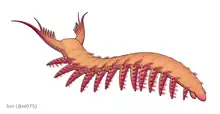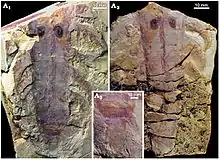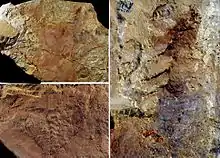| Jianshanopodia Temporal range: | |
|---|---|
 | |
| Reconstruction of Jianshanopodia decora | |
| Scientific classification | |
| Kingdom: | |
| Phylum: | †"Lobopodia" |
| Class: | |
| Order: | †Siberiida[1] |
| Family: | †Siberiidae[1] |
| Genus: | †Jianshanopodia |
| Species: | †J. decora Liu et al., 2006 |
Jianshanopodia decora is an extinct Cambrian lobopod. It lived in the territory of what is now China.[2]
Describtion

Fossil
Its frontal, grasping[3] appendages bear wedge-shaped plates. Its limbs branch,[2] instead of being tipped with claws as many lobopods' are.[3] Jianshanopodia has a sediment-filled gut surrounded by serially repeated diverticulae.[3][2] It is thought to have sucked up prey with its short 'trunk'.[3] It mainly crawled on the sea floor, but could swim when necessary.[3] Its mouth resembles those of anomalocaridids and priapulids.[4][5]
Phylogeny

Fossil
Phylogenetic position of Jianshanopodia according to Pates et al. (2022).[6]
| ||||||||||||||||||||||||||||||||||||||||||||||||||||||||||||||||||||||||||||||||||||||||||||||||||||
References
- 1 2 Dzik, Jerzy (2011). "The xenusian-to-anomalocaridid transition within the lobopodians" (PDF). Bollettino della Società Paleontologica Italiana. 50 (1): 65-74.
- 1 2 3 Jianni Liu; Degan Shu; Jian Han; Zhifei Zhang; Xingliang Zhang (2006). "A large xenusiid lobopod with complex appendages from the Lower Cambrian Chengjiang Lagerstätte". Acta Palaeontologica Polonica. 51 (2): 215–222. Retrieved 2015-03-13.
- 1 2 3 4 5 Liu, J.; Shu, D.; Han, J.; Zhang, Z.; Zhang, X. (2008). "Origin, diversification, and relationships of Cambrian lobopods". Gondwana Research. 14 (1–2): 277–283. Bibcode:2008GondR..14..277L. doi:10.1016/j.gr.2007.10.001.
- ↑ Vannier, Jean; Liu, Jianni; Lerosey-Aubril, Rudy; Vinther, Jakob; Daley, Allison C (2014). "Sophisticated digestive systems in early arthropods". Nature Communications. 5: 3641. Bibcode:2014NatCo...5.3641V. doi:10.1038/ncomms4641. PMID 24785191.
- ↑ Smith; Caron (2015). "Hallucigenia's head and the pharyngeal armature of early ecdysozoans" (PDF). Nature. 523 (7558): 75–8. Bibcode:2015Natur.523...75S. doi:10.1038/nature14573. PMID 26106857. S2CID 205244325.
- ↑ Pates, Stephen; Wolfe, Joanna M.; Lerosey-Aubril, Rudy; Daley, Allison C.; Ortega-Hernández, Javier (2022-02-09). "New opabiniid diversifies the weirdest wonders of the euarthropod stem group". Proceedings of the Royal Society B: Biological Sciences. 289 (1968). doi:10.1098/rspb.2021.2093. PMC 8826304. PMID 35135344.
This article is issued from Wikipedia. The text is licensed under Creative Commons - Attribution - Sharealike. Additional terms may apply for the media files.